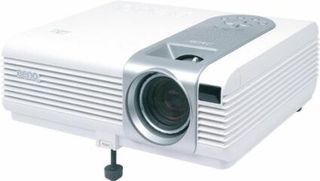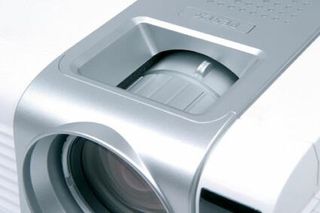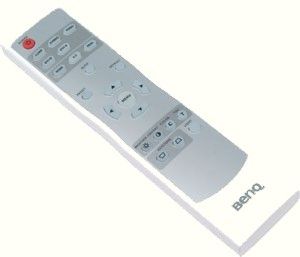Video Projectors: Evolving Towards High Definition
BenQ PE 5120

Based on a technology that's now well proven, the entry-level model from BenQ uses a 854x480 DLP chip, which is the minimum for a product intended for home theater use. The manufacturer's performance specs, however, suggested that the results would be quite good for this price range. Until now, brightness levels of 1100 lumens and a contrast ratio of 2000:1 were specifications only found on models costing up to twice the price of the PE 5120.
The DLP chip is associated with a 5-segment color wheel, for colors with better saturation and fidelity. Connectors include a DVI input for digital signals, an S-Video input, and component (YUV) and composite (RCA) inputs. While nothing's lacking, the inputs on this model aren't all identical in quality. We noted that the signals coming in via the S-Video input were low in quality, with washed-out colors that tended to bleed; the stability of the image was also limited. We advise you not to use this input and use one of the DVI or YUV connections instead. For the latter, you'll need to buy the appropriate cables with small connectors, because the structure of the projector's shell makes it impossible to insert large ones.

Now let's look at the external quality of the PE 5120. What stands out first of all about this model is the excellent overall build quality given its very reasonable price. The remote control is illuminated and also of high quality, with easy handling and a very handsome white lacquered finish. The plastics used don't look tacky and the overall white-and-gray finish is pleasant.
Installation
Light and with a small form factor, the PE 5120 will fit nicely in your living room, but is also easy to move around. When you sit it on a coffee table, you can adjust the tilt using a single foot located on the front center of the projector. There's also a keystone correction for adjusting the picture if necessary.
If you plan to use the BenQ in a fixed installation, you'll have to watch the two cooling fans on the rear of the case. The manufacturer advises that a space of around 4" (10 cm) be left clear behind the unit for proper ventilation. After a few minutes of operation, we could feel the heat the unit produces. For ceiling mounting on an arm, you have the possibility of mounting the projector upside down and inverting the picture.
Once set up and connected, the projector is turned on by pressing a button on the top of the shell. The fan comes on right away, but is fairly quiet. Though not among the lowest noise levels we've heard, it's still quite acceptable, and once you're watching your movie you'll soon forget all about it. The adjustment knobs and rings located around the lens make it easy to correct the sharpness of the picture and also to zoom in or out to suit the size of the image to your screen. The zoom is slightly above average, and you'll be able to get a 16:9 picture with a 6.5' (2 m) diagonal at a viewing distance of approximately 11' (3.3 m.) Obviously there are also several picture presets available, such as movie, video game, and economy. The movie mode is also best for screening DVDs. Your source is detected automatically provided you remember to enable that function in the menu.
Stay on the Cutting Edge
Join the experts who read Tom's Hardware for the inside track on enthusiast PC tech news — and have for over 25 years. We'll send breaking news and in-depth reviews of CPUs, GPUs, AI, maker hardware and more straight to your inbox.

Most Popular

